As an Amazon Associate KitchenwareSets.com earns from qualifying purchases.
11 Mexican Inspired Kitchen Ideas for Colorful Modern Charm
Is your kitchen just a place to cook, or is it the heart of your home? If you’re looking around and seeing a space that feels bland, functional but forgettable, and lacking in personality, you’re not alone. Many modern kitchens prioritize sterile efficiency over warmth and character, leaving you with a room that has no soul. You crave a space that feels vibrant, welcoming, and alive—a place where family gathers, stories are shared, and memories are made over delicious meals.
You’re tired of the endless sea of gray and white. You want to infuse your home with the kind of colorful, modern charm that feels both timeless and deeply personal. The challenge is knowing where to start. How do you combine bold colors without it feeling chaotic? How do you introduce rustic elements without the space looking dated? You’re looking for a way to blend rich cultural heritage with your contemporary lifestyle, creating a kitchen that is as beautiful as it is functional.
A Mexican-inspired kitchen is the perfect solution, offering a vibrant fusion of cultural heritage and modern design. It uses bold color palettes, handcrafted elements like Talavera tiles and rustic wood, and warm metal accents to create a space that is not only functional but also serves as the warm, inviting heart of the home. This ultimate guide for 2025 will show you exactly how to achieve it.
Craving a Kitchen with Soul? Here’s How to Infuse It with Authentic Mexican Charm
The core essence of a Mexican-inspired kitchen lies in its celebration of color, craftsmanship, and community. This design philosophy transforms the kitchen from a purely utilitarian room into the vibrant, soulful center of your home. It’s about creating a warm, inviting atmosphere that reflects a rich artistic heritage while seamlessly fitting into a modern lifestyle. By blending bold hues, natural textures, and handcrafted details, you can craft a space that feels both personal and timeless.
These ideas are not just about aesthetics; they are curated from authentic design principles and the lessons learned from countless successful modern remodels. This approach ensures you can achieve a look that is both culturally respectful and perfectly suited to your contemporary home, proving that you don’t have to sacrifice modern functionality for character and soul.
11 Mexican Inspired Kitchen Ideas for a Vibrant 2025 Makeover
Get ready to transform your space with 11 distinct and visually stunning ideas for a Mexican-inspired kitchen. This list combines timeless traditional elements with contemporary design trends, reflecting an expert curation for a balanced and stylish outcome. From major renovations like new flooring to simple decorative updates like displaying pottery, each idea is broken down into practical, actionable steps. This makes the vibrant and warm aesthetic of a Mexican style kitchen accessible for any home, regardless of size or budget.
@everyday_homedecor KITCHEN REVEAL IS HERE! I hope it was worth the wait! 🎉Making decisions for a kitchen renovation can feel so overwhelming but it’s so exciting to see it all come together! I wanted to honor the style of the house and my own personal style to create the perfect Spanish / Mexican Modern Kitchen! I will list some of the sources here but I’ll link anything that’s available in my bio (LTK). Backsplash: Tabarka Studio “Med 26” Cabinet color: @Benjamin Moore “Pashmina” Lights: spanishrevivallighting.com Ceramics: @Artesanias Patricia Gaytan Oax Stools: Etsy- linked in bio (shoutout to @Home Decor Creator for sharing them!) #señoralife #homedecor #modernmexican #mexicanmodernism #mexicandecor #mexicankitchen #spanishstylehome
Our top Mexican-inspired kitchen ideas include: 1. Vibrant Color Palettes, 2. Talavera Tile Backsplashes, 3. Rustic Wooden Elements, 4. Copper Accents, 5. Wrought Iron Hardware, 6. Terracotta Flooring, and more.
1. Embrace a Vibrant Color Palette
To define the Mexican aesthetic, use a color palette of bold, lively hues balanced with warm, neutral earth tones. This style draws inspiration from Mexico’s sun-drenched landscapes and vibrant folk art. Popular choices include warm terracotta, vibrant turquoise, sunny yellow, deep chili red, and forest green. The key is to use these colors thoughtfully, perhaps on an accent wall, the kitchen island, or cabinetry, and then ground the space with complementary neutrals to prevent the room from feeling overwhelming. This creates a cheerful, energetic atmosphere that is still warm and inviting.
- Materials Needed: High-quality interior paint (in turquoise, yellow, red, or green), neutral paint (cream or beige), painter’s tape, drop cloths, rollers, brushes, paint trays.
- Step-by-Step Directions:
- Choose a Focal Point: Select one wall (like the one behind the stove or sink) to be a bold accent wall. This creates a powerful statement without overwhelming the entire room.
- Select Your Hero Color: Pick a vibrant hue like a rich turquoise or a sunny yellow for your accent wall. This color will set the tone for the entire space.
- Balance with Neutrals: Paint the remaining walls and/or ceiling in a warm, neutral earth tone like sand, cream, or a soft terracotta. This grounds the bold color and keeps the space feeling balanced.
- Add Smaller Accents: If painting a full wall is too much for your taste, consider painting your kitchen island, a pantry door, or even just the inside of glass-front cabinets with your chosen bold color for a delightful pop.
Pro-Tip: Before committing to a color, always buy sample pots and paint large swatches on your wall. I can’t stress this enough. View them at different times of day, as natural and artificial light will dramatically change how the colors feel in your space. What looks like a perfect sunny yellow in the morning might feel too intense in the afternoon sun.
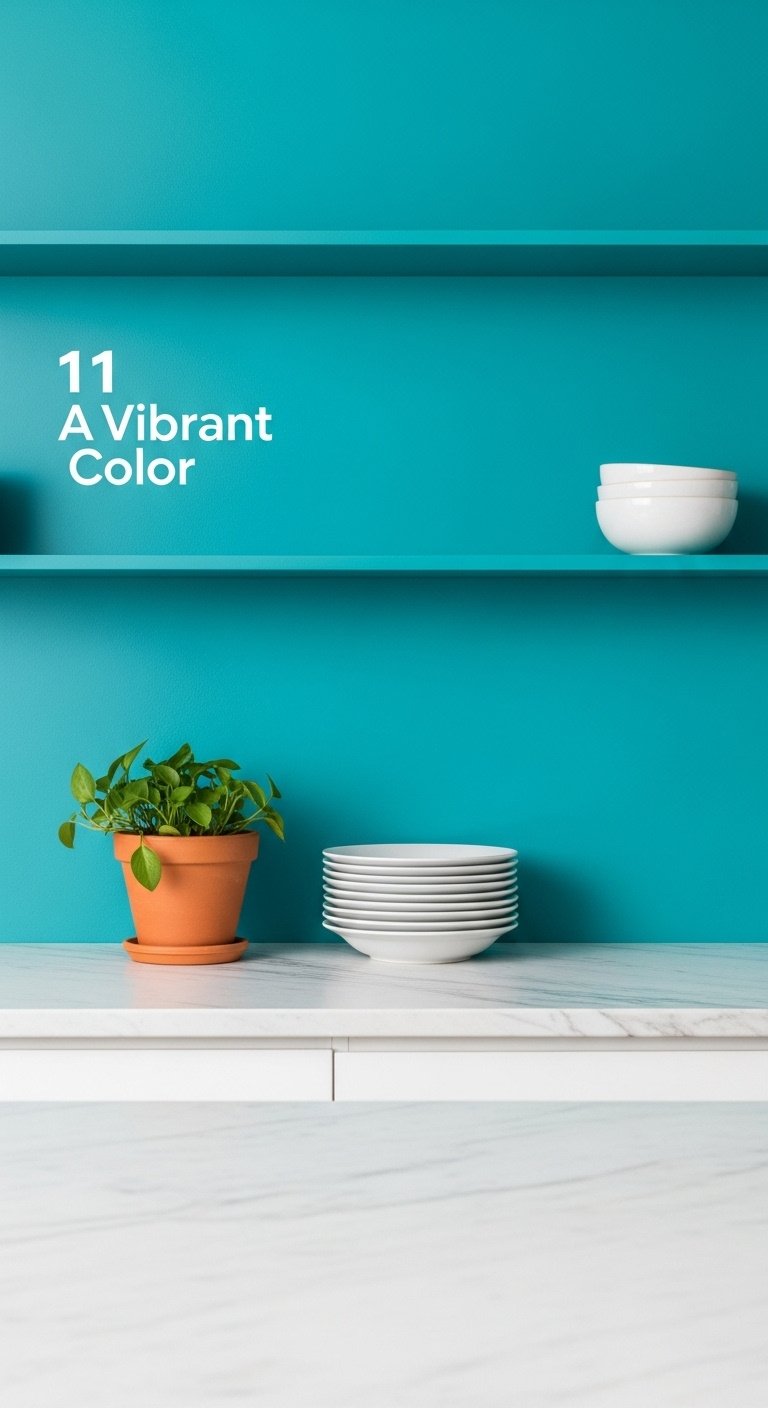
Pin this color inspiration for your dream kitchen makeover!
2. Install a Talavera Tile Backsplash
Talavera tiles are a quintessential element of Mexican kitchen design, known for their hand-painted ceramic artistry and intricate patterns. These traditional tiles, often featuring stunning designs in cobalt blue, sunshine yellow, and deep terracotta, create an immediate and authentic focal point. Using them for a backsplash not only adds a durable and easy-to-clean surface but also infuses the kitchen with unparalleled character and a celebration of craftsmanship. Mixing different patterns or framing them with solid-colored tiles can enhance the visual interest even further.
- Materials Needed: Authentic Talavera tiles, thin-set mortar, notched trowel, tile spacers, grout, grout float, sponge, bucket, tile saw (if needed).
- Step-by-Step Directions:
- Design Your Pattern: This is the fun part! Before you mix any mortar, lay out your tiles on the floor to arrange your mix of patterns and solid colors into a design you love. Take a picture to remember it.
- Prepare the Wall: Ensure the wall surface is clean, completely dry, and smooth. Any bumps or grease will prevent the tiles from adhering properly.
- Apply Mortar: Working in small, manageable sections, spread a thin layer of mortar on the wall with the notched side of your trowel.
- Set the Tiles: Press each tile firmly into the mortar with a slight twisting motion. Use tile spacers to maintain even gaps for the grout lines.
- Grout the Joints: After the mortar has cured (typically 24-48 hours), apply grout, pressing it into the joints diagonally with a grout float.
- Clean and Seal: Use a damp sponge to wipe away all the excess grout from the tile surfaces. Once the grout is fully cured, apply a quality sealant to protect it from future stains.
Lesson Learned: Authentic Talavera tiles are handmade, which means they can have slight variations in size, color, and thickness. My advice is to embrace these imperfections—they are what give the tiles their rustic, handcrafted charm. Crucially, always order 10-15% extra to account for necessary cuts and any potential breakage during installation.
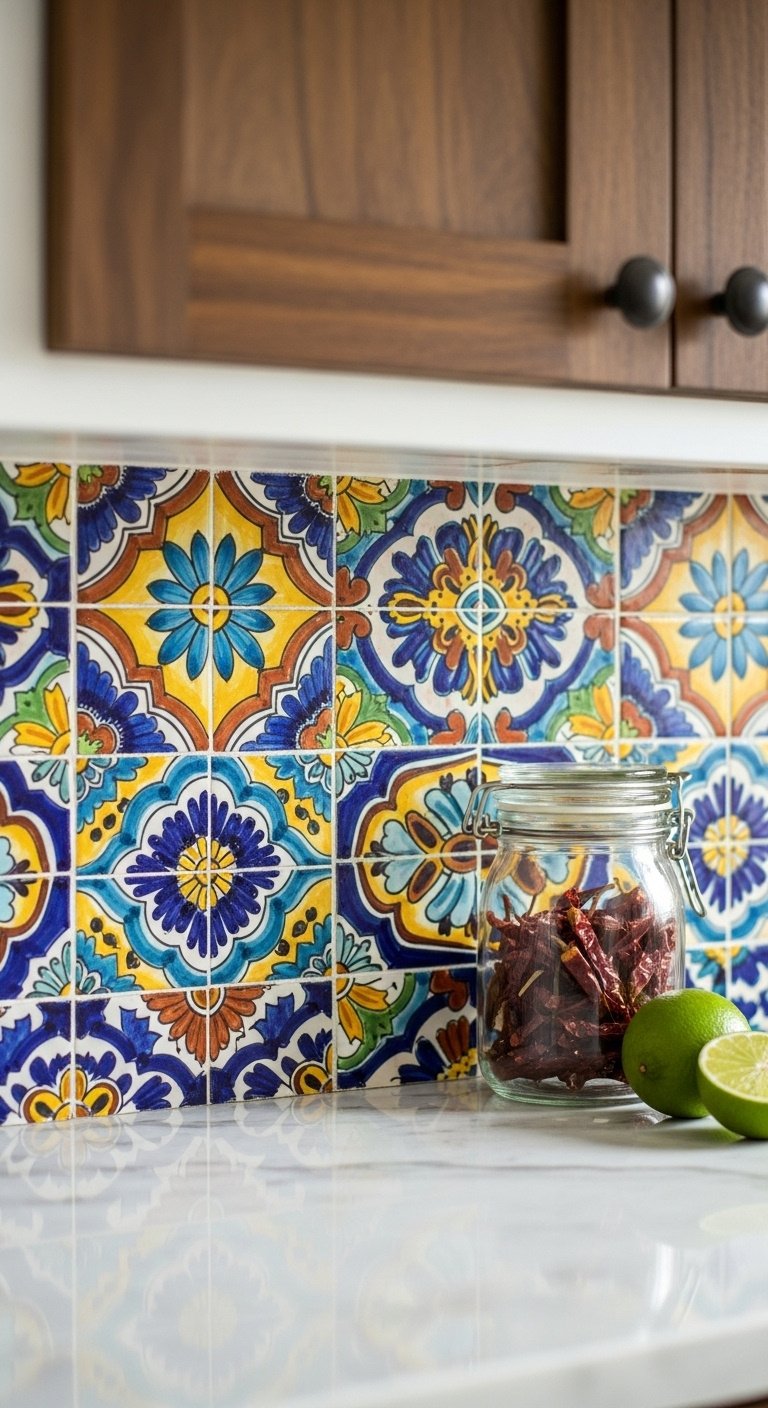
Save this authentic backsplash idea to your ‘Hacienda Home’ board!
3. Integrate Rustic Wooden Elements
To add immediate warmth and character, integrate rustic wooden elements like pine cabinets, exposed ceiling beams, or reclaimed wood shelving. Wood, particularly pine with its warm golden tones, brings a natural, lived-in charm that beautifully complements colorful tiles and metallic accents. Exposed wooden beams add dramatic architectural interest and a rustic hacienda feel, while open shelving made from reclaimed wood provides both functional storage and a perfect platform for displaying decorative items.
- Materials Needed: Reclaimed wood planks, heavy-duty shelf brackets, drill, level, wood stain or sealant, sandpaper.
- Step-by-Step Directions:
- Source Your Wood: Visit a local architectural salvage yard to find reclaimed wood planks with authentic character. Alternatively, you can distress new pine planks for a similar effect.
- Prepare the Shelves: Cut the planks to your desired length. Sand them just enough to smooth out any splinters, but be sure to leave some of the natural imperfections and saw marks for character.
- Stain or Seal: Apply a natural wax, oil, or a dark stain to the wood. This not only protects the wood but also enhances its natural grain and deepens its color.
- Install Brackets: Secure heavy-duty brackets to the wall studs using a drill and a level to ensure they are straight. Wrought iron brackets are an excellent choice to continue the theme.
- Mount Shelves: Place your finished wooden planks onto the brackets and secure them from underneath so they are stable and safe.
Pro-Tip: For ceiling beams, consider using high-quality faux wood beams. From personal experience, they are a game-changer. They are lightweight, significantly easier and safer to install than solid wood beams, and the modern finishes are incredibly realistic, perfectly capturing the hand-hewn look without the structural engineering hassle.
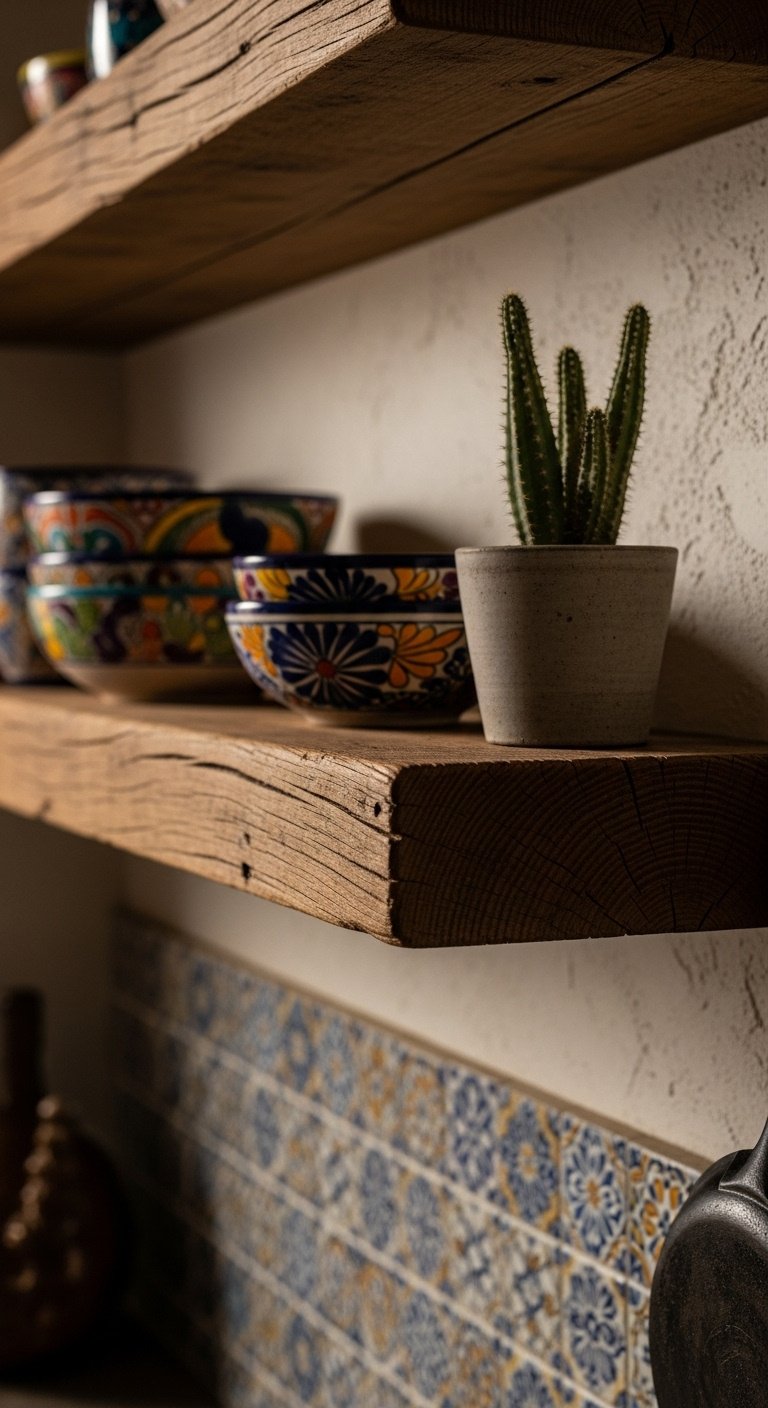
Love this rustic look? Share it with a friend who would too!
4. Feature Warm Copper Accents
You can introduce a warm, artisanal beauty by featuring copper accents in key areas like the range hood, sink, lighting, or hardware. Copper is a versatile metal whose warm, reddish-brown tones and natural patina bring an unmatched depth and character to a kitchen. A hand-hammered copper farmhouse sink or a statement range hood can serve as a stunning focal point. On a smaller scale, copper pot racks, cabinet hardware, or even a collection of copper cookware on display adds a touch of authentic Mexican craftsmanship and complements earthy ceramics and natural wood beautifully.
- Materials Needed: Copper cabinet pulls/knobs, screwdriver, copper pendant light, copper pot rack kit.
- Step-by-Step Directions:
- Start Small: An easy and impactful entry point is swapping out your existing cabinet hardware. Simply unscrew the old pulls and replace them with new hand-hammered copper ones.
- Upgrade Lighting: Replace a standard light fixture over your kitchen island or sink with a statement-making copper pendant light to draw the eye upward.
- Add Functional Decor: Install a copper pot rack to display your favorite cookware. This adds a beautiful metallic element while also freeing up precious cabinet space.
- Accessorize: Introduce smaller, movable copper items like a set of canisters for flour and sugar, a tea kettle that lives on the stove, or a large fruit bowl as a centerpiece.
Pro-Tip: Unsealed copper will naturally develop a patina (a beautiful greenish-blue tarnish) over time due to oxidation. Many people, myself included, love this for its authentic, aged look. If you prefer the shiny new-penny look, you can easily maintain it by cleaning it regularly with a simple mixture of lemon juice and salt or a commercial copper cleaner.
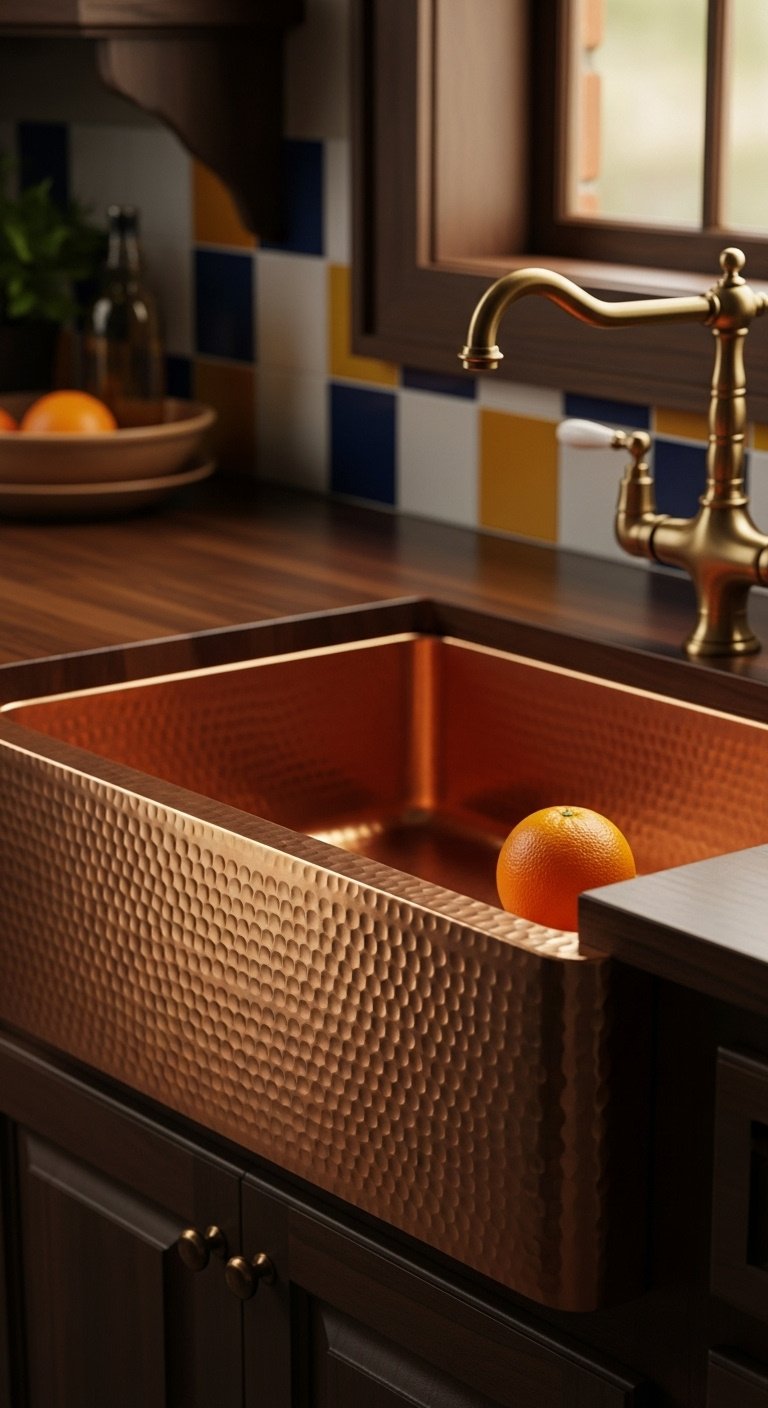
Save this warm metallic inspiration to your ‘Kitchen Finishes’ board!
5. Use Authentic Wrought Iron Hardware
For a touch of rustic sophistication, use authentic wrought iron for hardware, lighting fixtures, and decorative brackets. This heavy, hand-forged metal is a hallmark of the Spanish and Mexican hacienda style. The dark, matte finish of wrought iron creates a beautiful and dramatic contrast against light-colored wood cabinets or vibrant tile surfaces. Incorporating it through cabinet pulls, hinges, pot racks, or even a grand chandelier can instantly add a sense of history and artistry to the space, celebrating the craft of Mexican metalworkers.
- Materials Needed: Wrought iron cabinet hardware (pulls, knobs, hinges), wrought iron shelf brackets, screwdriver, drill, level.
- Step-by-Step Directions:
- Upgrade Cabinets: A simple but effective change is to replace standard cabinet hardware with heavy, hand-forged wrought iron pieces. Look for rustic styles like mission pulls, ring pulls, or simple latches.
- Expose the Hinges: For a truly authentic look, use decorative exterior wrought iron strap hinges on your cabinet doors, making a feature of the hardware itself.
- Support Shelving: Use ornate, scrolled wrought iron brackets to support your rustic open shelving. This combines function with beautiful, decorative detail.
- Light it Up: A large, multi-armed wrought iron chandelier suspended above a kitchen island or dining table creates a dramatic, hacienda-style centerpiece that anchors the entire room.
Lesson Learned: Quality really matters with wrought iron. When shopping, look for pieces that feel heavy and substantial in your hand. True hand-forged iron will have slight irregularities and subtle hammer marks that distinguish it from cheaper, mass-produced cast iron, and it’s these imperfections that give it its true character.
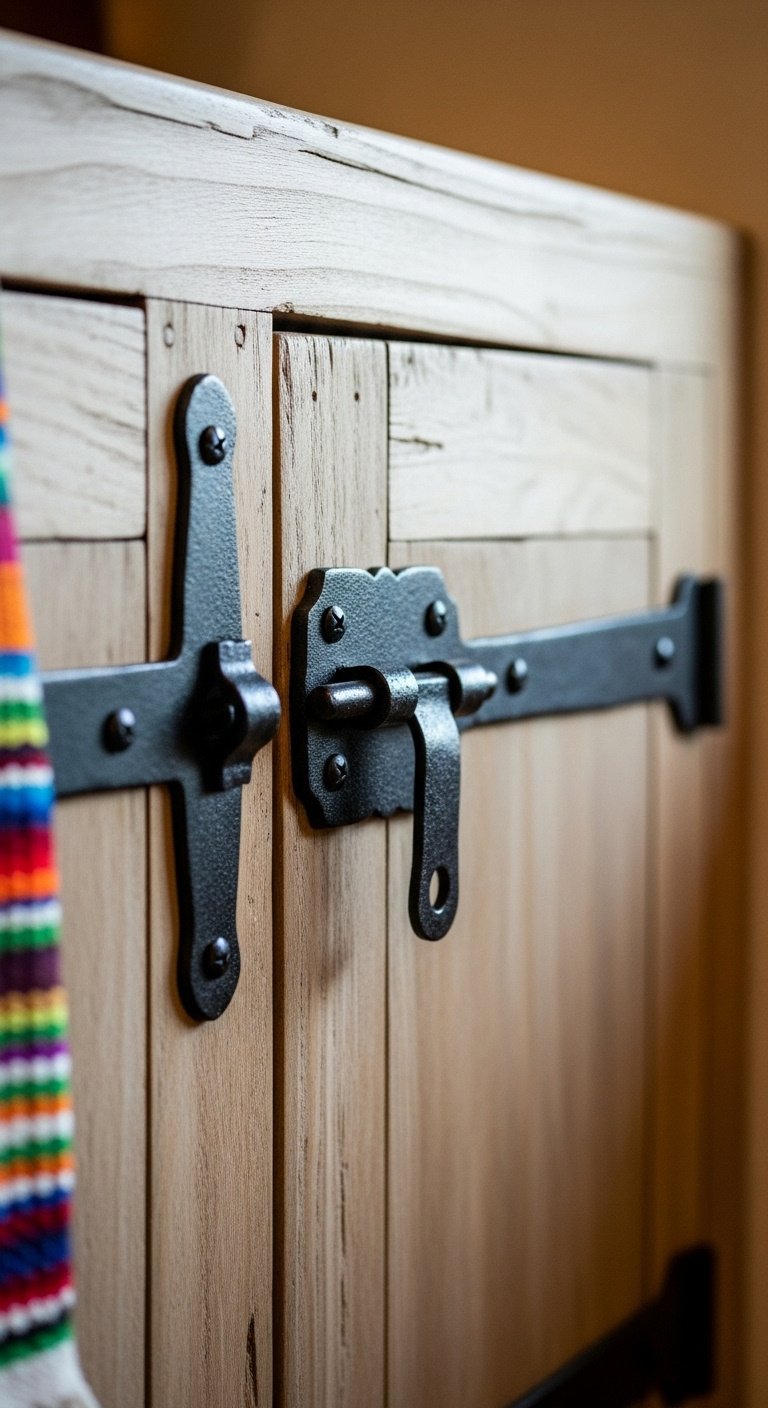
Pin this authentic hardware detail for your next project!
6. Lay Down Earthy Terracotta Flooring
To create an authentic foundation for your kitchen, choose earthy terracotta floor tiles for their warmth and character. These handmade tiles, crafted from natural clay, feature subtle color variations and organic textures that develop a beautiful aged patina over time. The warm reddish-brown tones of terracotta (also known as Saltillo tile) create the perfect canvas for colorful wall tiles and vibrant accessories. Beyond its beauty, terracotta is durable for high-traffic areas and feels comfortable underfoot.
- Materials Needed: Terracotta/Saltillo tiles, tile adhesive, grout, notched trowel, grout float, tile spacers, high-quality penetrating sealer.
- Step-by-Step Directions:
- Prepare the Subfloor: Your subfloor must be perfectly level, clean, and free of any debris or dust to ensure proper adhesion.
- Seal Before Laying: This is a crucial step! Because terracotta is highly porous, I strongly recommend applying a coat of sealer to the tiles before installation. This prevents them from absorbing moisture from the adhesive and grout, which can cause discoloration.
- Lay the Tiles: Apply your adhesive and set the tiles, using spacers to maintain consistent grout lines for a professional finish.
- Grout and Clean: After the adhesive has fully cured, apply your grout to the joints. Be sure to clean off any excess grout from the tile surfaces immediately with a damp sponge.
- Seal Again (and Again): Once the grout is fully cured, apply several coats of a high-quality penetrating sealer to the entire floor. This is essential to protect the porous tiles from stains and moisture.
Pro-Tip: Saltillo tiles, a famous type of terracotta from Saltillo, Mexico, are notoriously soft and prone to chipping. This “distressing” is actually considered part of their charm and helps them develop that beautiful, aged patina over time. However, if you want the look but need more durability for a busy family kitchen, look for high-quality, machine-made terracotta tiles that mimic the rustic look with a higher density.
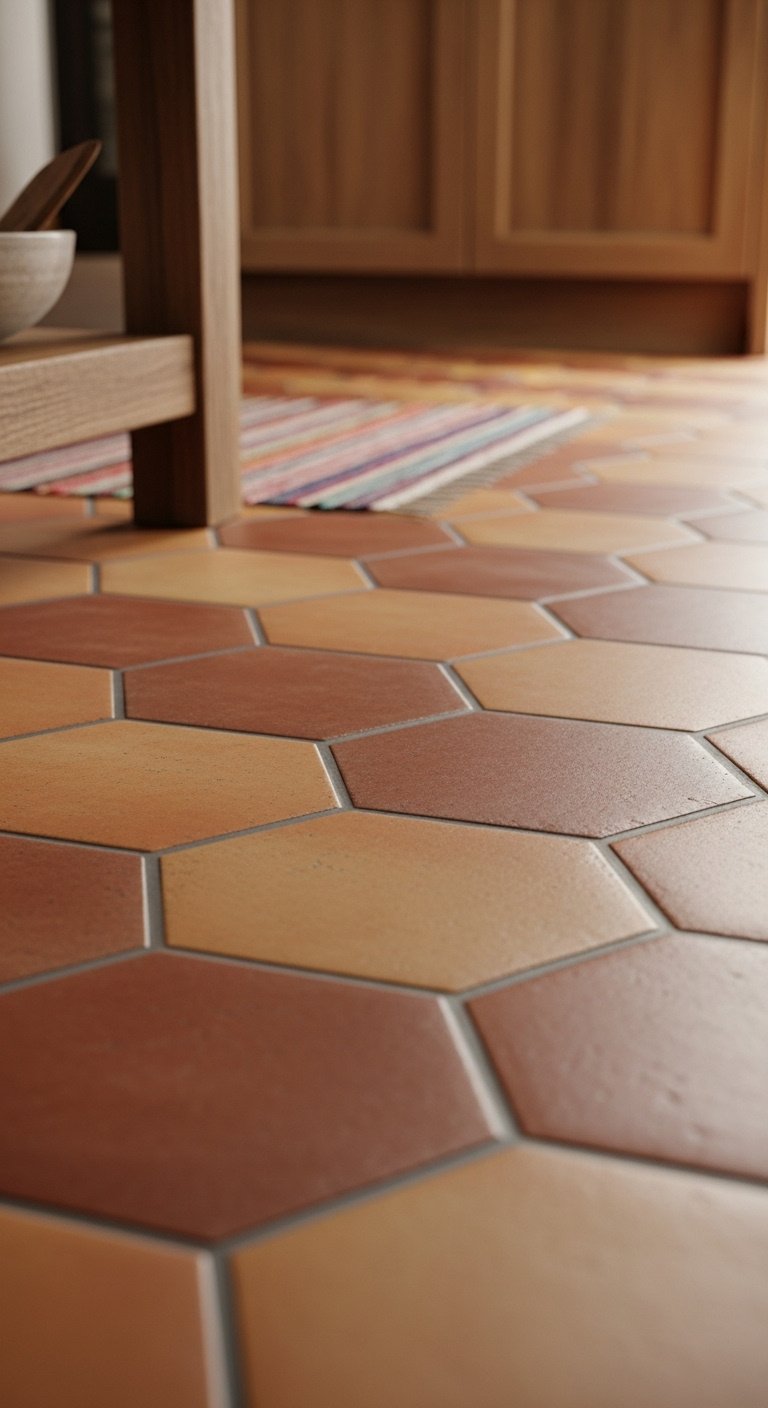
Fall in love with this floor? Save it to your ‘Dream Home’ board!
7. Display Colorful Pottery and Ceramics
A key aspect of Mexican kitchen design is showcasing collections of vibrant, handcrafted pottery for both functional and decorative purposes. Hand-painted ceramic pieces from renowned artistic regions like Oaxaca and Tlaquepaque add an authentic artistic flair. Displaying colorful bowls, pitchers, and serving platters on open shelving or inside glass-front cabinets creates instant visual interest and turns everyday items into a beautiful art installation, celebrating Mexico’s rich ceramic heritage.
- Materials Needed: A collection of Mexican pottery, open shelving or a hutch, plate stands, museum putty (optional).
- Step-by-Step Directions:
- Curate Your Collection: You don’t need to buy everything at once. Start by collecting a few key pieces that you love—a large water pitcher, a set of colorful bowls, or a statement serving platter. Mix different patterns and colors for a vibrant, eclectic look.
- Designate a Display Space: Dedicate a specific set of open shelves, a freestanding hutch, or a glass-front cabinet as your main display area to make the collection feel intentional.
- Create Visual Layers: Arrange your items with purpose. Place larger platters and plates at the back, using plate stands to prop them up. Layer smaller bowls, cups, and pitchers in front to create depth.
- Group by Color or Use: Create pleasing little vignettes by grouping items of a similar color together. Alternatively, for a functional approach, group all your coffee mugs in one spot for a display that’s both beautiful and practical for daily use.
Pro-Tip: For displaying valuable or delicate ceramic pieces on open shelves, especially if you live in an earthquake-prone area, I always use a small, removable amount of museum putty on the bottom of each item. It’s invisible and will secure the piece firmly without damaging it or the shelf surface.
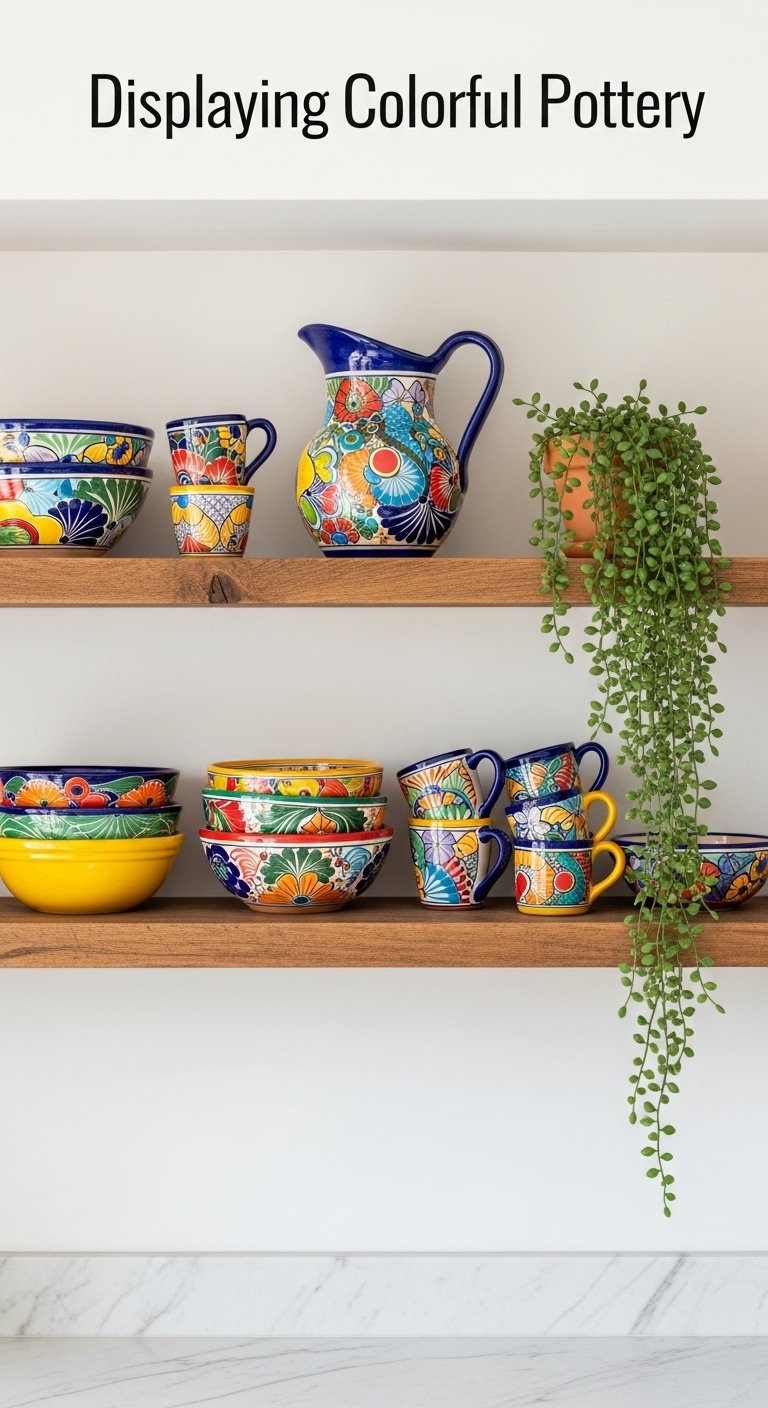
Pin this beautiful display idea for your own collection!
8. Utilize Open Shelving
To make your kitchen feel more open and airy, incorporate rustic open shelving to display your beautiful dishes, pottery, and glassware. This approach provides highly functional storage while also serving as a key decorative element in a Mexican-inspired kitchen. Using thick planks of rustic or reclaimed wood complements the overall aesthetic perfectly. The key to making open shelving work in a modern context is a thoughtful arrangement of items, creating a look that is both visually pleasing and practical for daily use.
- Materials Needed: Thick wooden planks, shelf brackets (wrought iron or simple metal), drill, level, stud finder.
- Step-by-Step Directions:
- Remove Upper Cabinets: For a bold and transformative change, carefully remove a section of your existing upper cabinets to open up the space. You’ll need to patch and paint the wall behind them.
- Locate Studs: Use a stud finder to locate the wall studs. This is absolutely crucial for ensuring your shelves can safely support the weight of your dishes and cookware.
- Install Brackets: Securely mount your chosen brackets directly into the wall studs using a drill and a level.
- Place and Style Shelves: Place your wooden shelves on the brackets. Now for the fun part: arrange your everyday dishes, colorful pottery, and glassware. Mix in woven baskets for texture and a few small plants to bring in life and color.
Lesson Learned: The absolute key to successful open shelving is curation. I’ve seen it go wrong when people try to cram too much on them. The secret is to not overcrowd them. Display your most beautiful and frequently used items, and store the less attractive plastic containers and mismatched items in your lower cabinets or pantry. This keeps the look clean, airy, and functional, not cluttered.
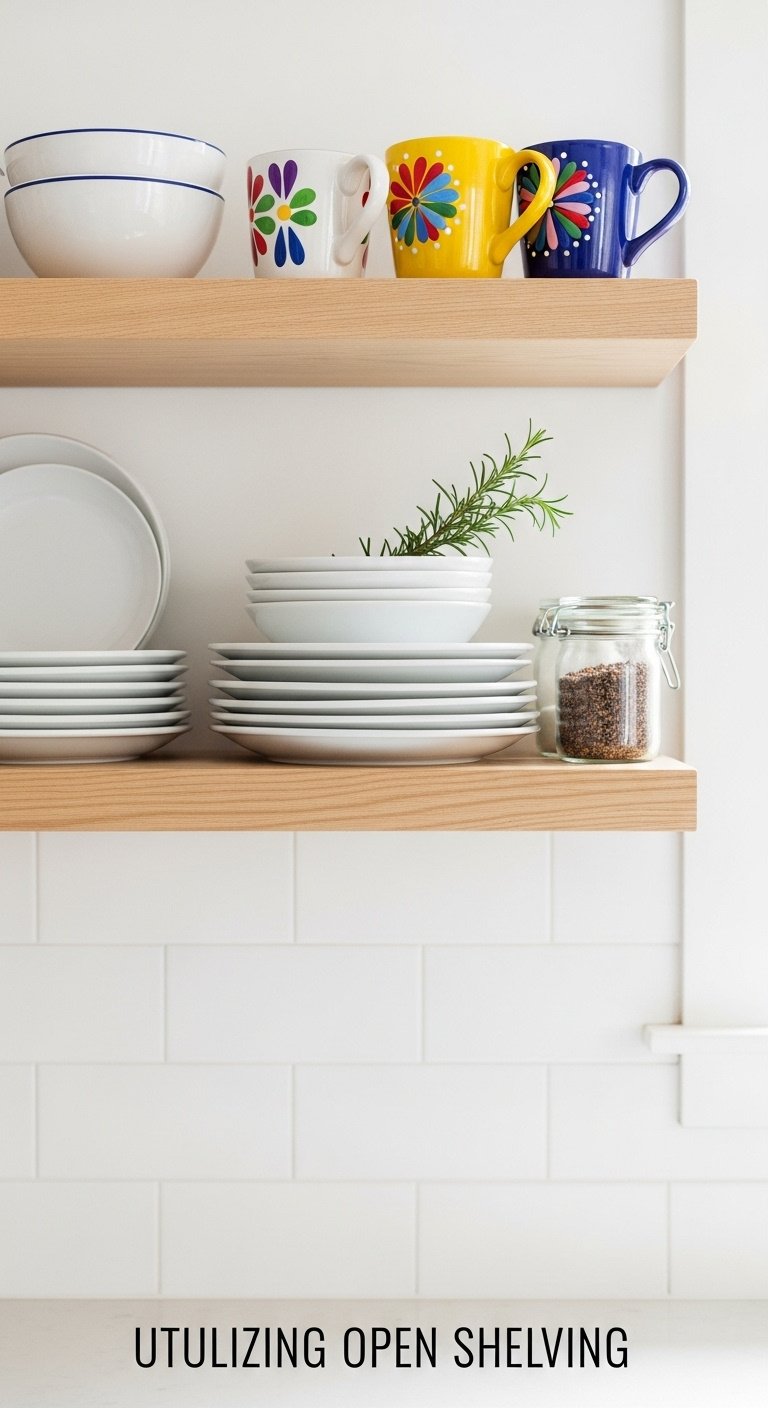
Want this airy look? Save this idea to your ‘Kitchen Remodel’ board!
9. Choose Natural Stone Countertops
For a durable and beautiful work surface, choose natural stone countertops like granite, marble, or local Mexican varieties like Cantera stone. These surfaces bring geological beauty and unique organic patterns that perfectly complement handmade tiles and rustic wood. Stone’s natural heat resistance makes it incredibly practical for a busy kitchen, and its inherent variations ensure that each installation is one-of-a-kind. Opting for a neutral tone of stone provides an excellent, calm backdrop that allows your vibrant tile backsplash and colorful pottery displays to truly shine.
- Materials Needed: This is not a DIY project; you will need a professional countertop installer.
- Step-by-Step Directions:
- Research Materials: Take your time exploring different types of stone. Granite is famously durable and comes in a vast array of colors. Marble is classically beautiful but requires more maintenance to prevent stains and etching. For a truly authentic touch, consider local options like Cantera stone.
- Choose a Neutral Base: I recommend selecting a stone in a neutral, earthy tone—think beige, cream, light grey, or warm brown—with subtle veining or patterning. This provides a calm, elegant backdrop that won’t compete with the other vibrant elements in your kitchen.
- Visit a Stone Yard: You must do this! Go to a stone yard to see the full slabs in person. The small square samples you see in showrooms don’t do justice to the full pattern and color variation of the stone.
- Get Professional Templating and Installation: Hire a reputable company to come to your home to create a precise measurement (a template) and then professionally install your countertops to ensure a perfect fit around your sink and appliances.
Pro-Tip: Always insist that your new countertop is sealed by the installers upon installation. Natural stone is porous, and a good quality sealer is absolutely essential to protect it from stains, especially from common kitchen culprits like red wine, olive oil, and citrus juice. Plan to re-seal it every 1-2 years as recommended by your installer to keep it looking pristine.
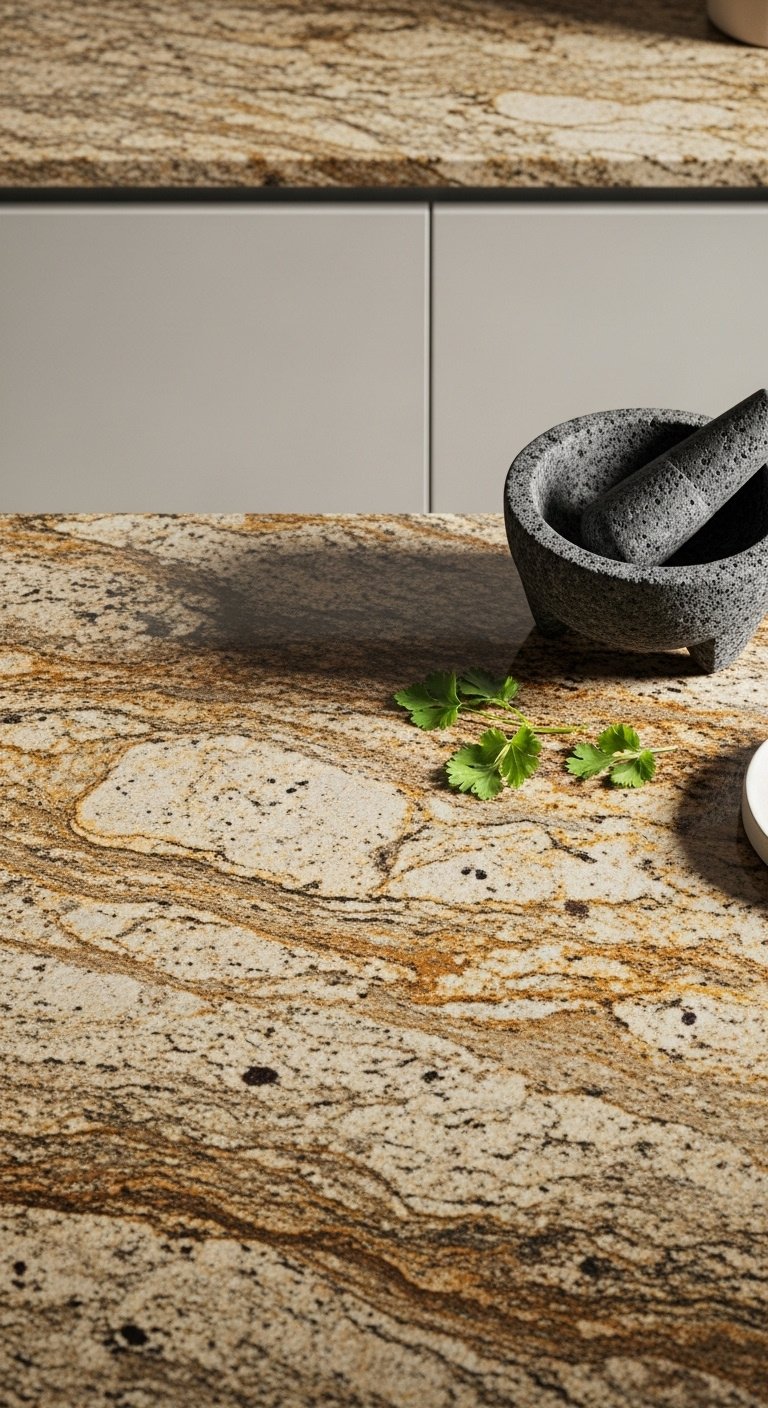
Love this durable style? Pin it for your countertop selection!
10. Cultivate an Integrated Herb Garden
A simple way to bring fresh flavor and life into your kitchen is to cultivate an integrated herb garden in traditional clay pots. This functional element adds authentic character and contributes to a biophilic design that enhances the entire kitchen environment. Windowsill planters, hanging garden systems, or a dedicated growing area near a sunny window provide year-round access to fresh herbs like cilantro, oregano, and chili plants, connecting your cooking space directly to the fresh ingredients central to Mexican cuisine.
- Materials Needed: Several small terracotta pots, good-quality potting soil, herb seedlings (cilantro, oregano, mint, chili peppers), a sunny windowsill or wall-mounted planters.
- Step-by-Step Directions:
- Choose Your Location: Find the sunniest spot in your kitchen. Ideally, this is a windowsill that gets at least 4-6 hours of direct sunlight per day.
- Select Your Pots: Use classic terracotta pots that have drainage holes at the bottom. Terracotta is breathable, which helps keep the soil from getting waterlogged, and its earthy color fits the aesthetic perfectly.
- Plant Your Herbs: Fill the pots with potting soil. Gently remove your herb seedlings from their containers, place them in the soil, and water them well.
- Arrange and Maintain: Arrange your lovely new pots on the windowsill. Water them whenever the top inch of soil feels dry to the touch. Snip leaves as you need them for cooking—regular trimming actually encourages the plants to grow fuller and bushier.
Lesson Learned: From my own experience, cilantro can be a bit tricky to grow indoors as it has a tendency to “bolt” (flower and go to seed) very quickly. For a more continuous supply, I’ve found the best method is to plant a new batch of seeds every few weeks so you always have a fresh plant ready to go.
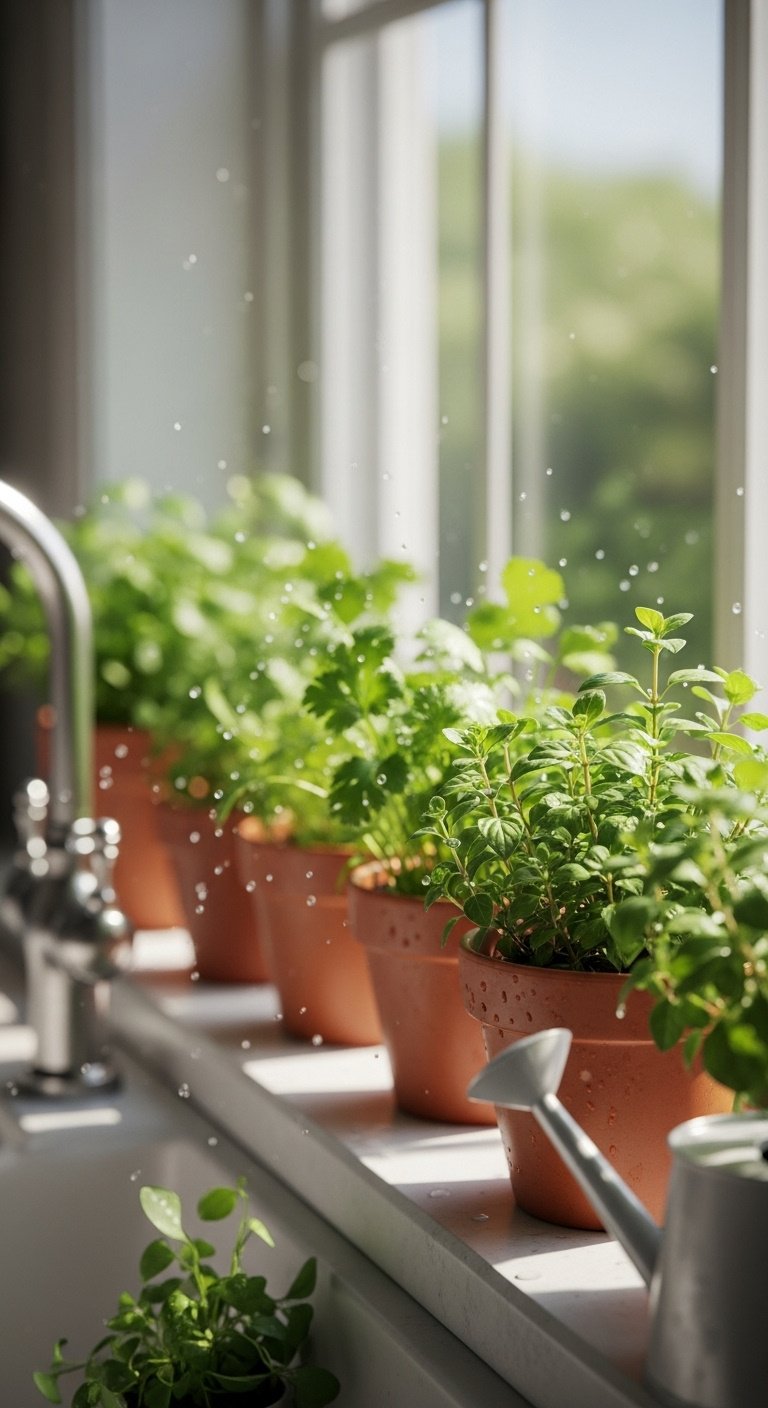
Add some green to your feed! Save this fresh idea.
11. Try Hand-Painted Cabinet Designs
For a truly unique and artistic statement, transform plain cabinets by adding hand-painted designs inspired by Mexican folk art traditions. This custom treatment can turn simple wood surfaces into stunning artistic expressions that reflect regional styles. Using colorful motifs, intricate floral patterns, or decorative borders in vibrant blues, warm reds, and golden yellows can create a unique focal point that celebrates Mexican artistic heritage in a deeply personal way.
- Materials Needed: Fine-grit sandpaper, primer, base coat paint, acrylic craft paints in various colors, fine-tipped artist brushes, stencils (optional), clear polyurethane topcoat.
- Step-by-Step Directions:
- Prep the Surface: For the best results, remove the cabinet doors. Lightly sand the surface, wipe it clean, and apply a coat of high-quality primer. Once dry, apply your neutral base coat color.
- Sketch or Stencil Your Design: Lightly sketch a simple floral or geometric border design with a pencil. If you’re not confident in your freehand skills, stencils are a fantastic tool for creating a more uniform look.
- Paint the Details: Using fine-tipped artist brushes and your vibrant acrylic paints, carefully fill in your design. Remember, slight variations and imperfections are part of the handcrafted charm, so don’t worry about being perfect!
- Protect Your Work: Once the decorative paint is completely dry, apply 2-3 thin coats of a clear polyurethane topcoat (in a satin or matte finish) to protect your beautiful design from the wear and tear of daily kitchen use.
Pro-Tip: If the thought of painting all your cabinets feels overwhelming, start with a smaller, more manageable accent piece. The kitchen island, a freestanding pantry cabinet, or even a simple wooden stool can be transformed into a beautiful focal point with a hand-painted design, giving you a taste of the process without committing to the whole room at once.
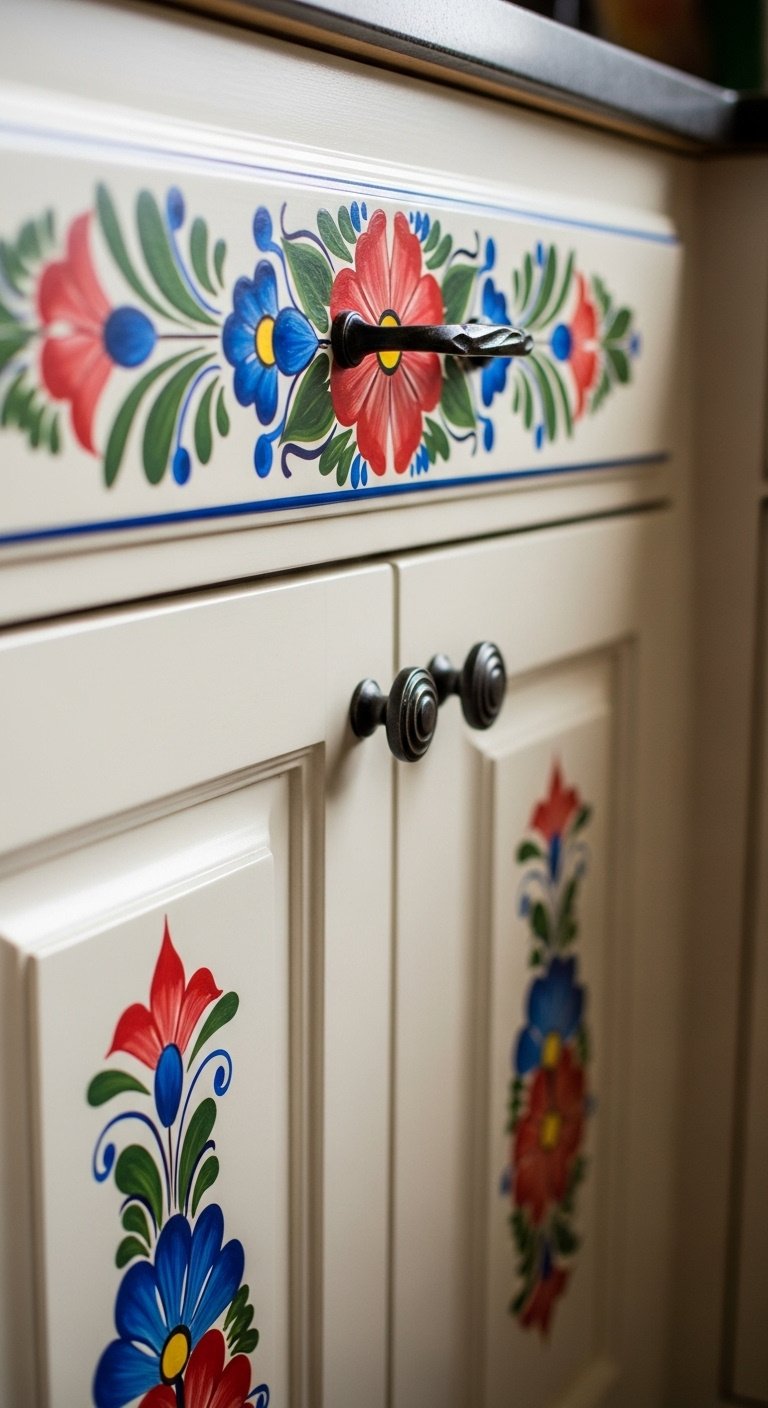
Unleash your inner artist! Save this custom cabinet idea.
Key Takeaways: Your Quick Guide to a Mexican Inspired Kitchen
Feeling inspired? Here’s a quick summary of the core principles to keep in mind as you design the Mexican-inspired kitchen of your dreams. This scannable list reinforces the main points and serves as a handy reference guide.
- Embrace Color: Don’t be shy with vibrant hues like turquoise, yellow, and red. The secret is to balance them with plenty of warm earth tones like terracotta, sand, and cream for a look that’s energetic but not overwhelming.
- Focus on Handcrafted Elements: Prioritize materials that show the mark of a human hand. Think authentic Talavera tiles with their slight imperfections, hand-hammered copper sinks, and rustic, reclaimed wood.
- Layer Textures: Create visual depth and interest by combining a variety of textures. Mix smooth stone countertops with rough wooden beams, glossy ceramic tiles, and matte terracotta floors.
- Decorate with Purpose: Let your functional items double as decor. Use colorful, hand-painted pottery and shiny copper pots as key decorative features by displaying them proudly on open shelving.
- Bring Nature In: A few fresh herbs growing in terracotta pots on the windowsill can do wonders. They add life, vibrant green color, and delicious flavor, connecting your kitchen directly to the earth.
People Also Ask About a Mexican Inspired Kitchen
Have more questions? You’re not alone. Here are direct answers to some of the most common queries people have when exploring this vibrant and warm kitchen style.
What is a Spanish style kitchen?
A Spanish-style kitchen often shares elements with Mexican design, like terracotta floors and wrought iron, but typically features more ornate, dark wood cabinetry. You’ll also see intricate Moorish-inspired tile patterns, which are distinct from the folk-art style of Talavera. They often incorporate architectural details like arched doorways and windows, giving the overall feel a more formal, Old World European character.
What are the colors of Mexican kitchens?
Mexican kitchens are celebrated for their bold, vivid color palettes inspired by nature, spices, and art. Key colors include warm terracotta, vibrant turquoise, sunny yellow, deep chili red, and lush forest green. These bright hues are almost always balanced with neutral earth tones like sand, beige, and the natural tones of wood to create a space that is lively, cheerful, and grounded.
What do furnishings in a typical Mexican home look like?
Furnishings in a typical Mexican home often feature rustic, solid wood pieces, like pine or mesquite, with natural finishes or detailed carvings. Wrought iron is a common material found in lighting fixtures, chair backs, and table bases. Crucially, textiles play a huge role in adding warmth and color, with hand-woven rugs, colorful blankets (serapes), and intricately embroidered pillows used to add texture and vibrancy throughout the space.
Final Thoughts
Creating a Mexican-inspired kitchen is about so much more than just following a design trend; it’s about consciously choosing to fill the heart of your home with warmth, personality, and a celebration of artistry. It’s about building a space that invites people in, encourages long conversations, and serves as the perfect backdrop for making memories. Whether you start with a bold new wall color or a single piece of handcrafted pottery, you’re on your way to creating a kitchen with true soul.
Which of these ideas are you most excited to try in your own kitchen? Let us know in the comments below
